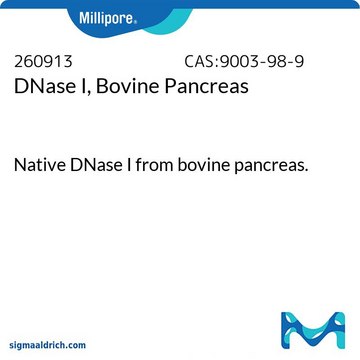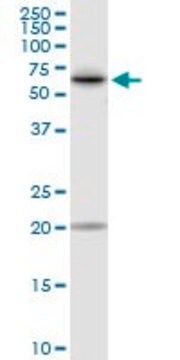Key Documents
AMPD1
DNase I
Amplification Grade
Synonim(y):
Deoxyribonuclease I
About This Item
Polecane produkty
Poziom jakości
Postać
liquid
stężenie
1 unit/μL
metody
RT-PCR: suitable
kolor
colorless
Warunki transportu
wet ice
temp. przechowywania
−20°C
Powiązane kategorie
Opis ogólny
DNase I digests double- and single-stranded DNA into oligo- and mononucleotides. Using the Reaction Buffer provided, DNA is removed from RNA preparations in a 15 minute digestion at room temperature. The DNase I is then inactivated by heating with the Stop Solution. Heating also denatures hairpins in the RNA, so the RNA can be used directly in reverse transcription.
No current RNA isolation procedure removes 100% of the DNA. Many commercial DNase I formulations are contaminated with residual RNases. This RNase contamination can destroy or degrade valuable RNA samples prior to reverse transcription. Laboratory comparisons have shown that Sigma′s Amplification Grade DNase I demonstrates lower RNase activity than that from several leading molecular biology product suppliers.
Zastosowanie
- for the digestion of DNA during isolation and purification of RNA. The purified RNA can be used for the synthesis of cDNA using RNA reverse transcriptase.
- to hydrolyze extracellular matrix (ECM) components and enhance photosensitizer penetration into the biofilm to determine the efficacy of antimicrobial photodynamic therapy (aPDT) on Candida albicans biofilms
- to remove contaminating DNA from total RNA extracted from cattle blood samples
Cechy i korzyści
- Suitable for the elimination of DNA from RNA
- Minimal RNase activity available
- Optimized 10× reaction buffer and Stop Solution for complete inactivation of DNase I
Przydatność
Definicja jednostki
Informacje prawne
inhibitor
produkt powiązany
Kod klasy składowania
10 - Combustible liquids
Temperatura zapłonu (°F)
Not applicable
Temperatura zapłonu (°C)
Not applicable
Certyfikaty analizy (CoA)
Poszukaj Certyfikaty analizy (CoA), wpisując numer partii/serii produktów. Numery serii i partii można znaleźć na etykiecie produktu po słowach „seria” lub „partia”.
Masz już ten produkt?
Dokumenty związane z niedawno zakupionymi produktami zostały zamieszczone w Bibliotece dokumentów.
Klienci oglądali również te produkty
Produkty
Zastosowanie oligos modyfikowanych lipidami MULTI-seq, protokół i przewodnik rozwiązywania problemów dla testów PCR i aplikacji sekwencjonowania.
Protokoły
Method for reverse transcription of RNA into DNA. Uses a premixed reagent that contains reverse transcriptase, dNTPs, primers, RNase inhibitor and buffer. Fast generation of cDNA.
The SeqPlex RNA Amplification kit provides a method for amplification of total RNA or isolated mRNA prior to entry into the workflows of the commonly used deep sequencing platforms.
Powiązane treści
Spectrum Plant Total RNA Kit oczyszcza RNA z trudnych gatunków i tkanek za pomocą zgłoszonej do opatentowania chemii.
Polymerase chain reaction (PCR) is a technique for amplifying nucleic acid molecules and is commonly used in many applications, including RT-PCR, hot start PCR, end point PCR and more.
Reakcja łańcuchowa polimerazy (PCR) jest techniką amplifikacji cząsteczek kwasów nukleinowych i jest powszechnie stosowana w wielu aplikacjach, w tym RT-PCR, hot start PCR, end point PCR i innych.
Reakcja łańcuchowa polimerazy (PCR) jest techniką amplifikacji cząsteczek kwasów nukleinowych i jest powszechnie stosowana w wielu aplikacjach, w tym RT-PCR, hot start PCR, end point PCR i innych.
Nasz zespół naukowców ma doświadczenie we wszystkich obszarach badań, w tym w naukach przyrodniczych, materiałoznawstwie, syntezie chemicznej, chromatografii, analityce i wielu innych dziedzinach.
Skontaktuj się z zespołem ds. pomocy technicznej












